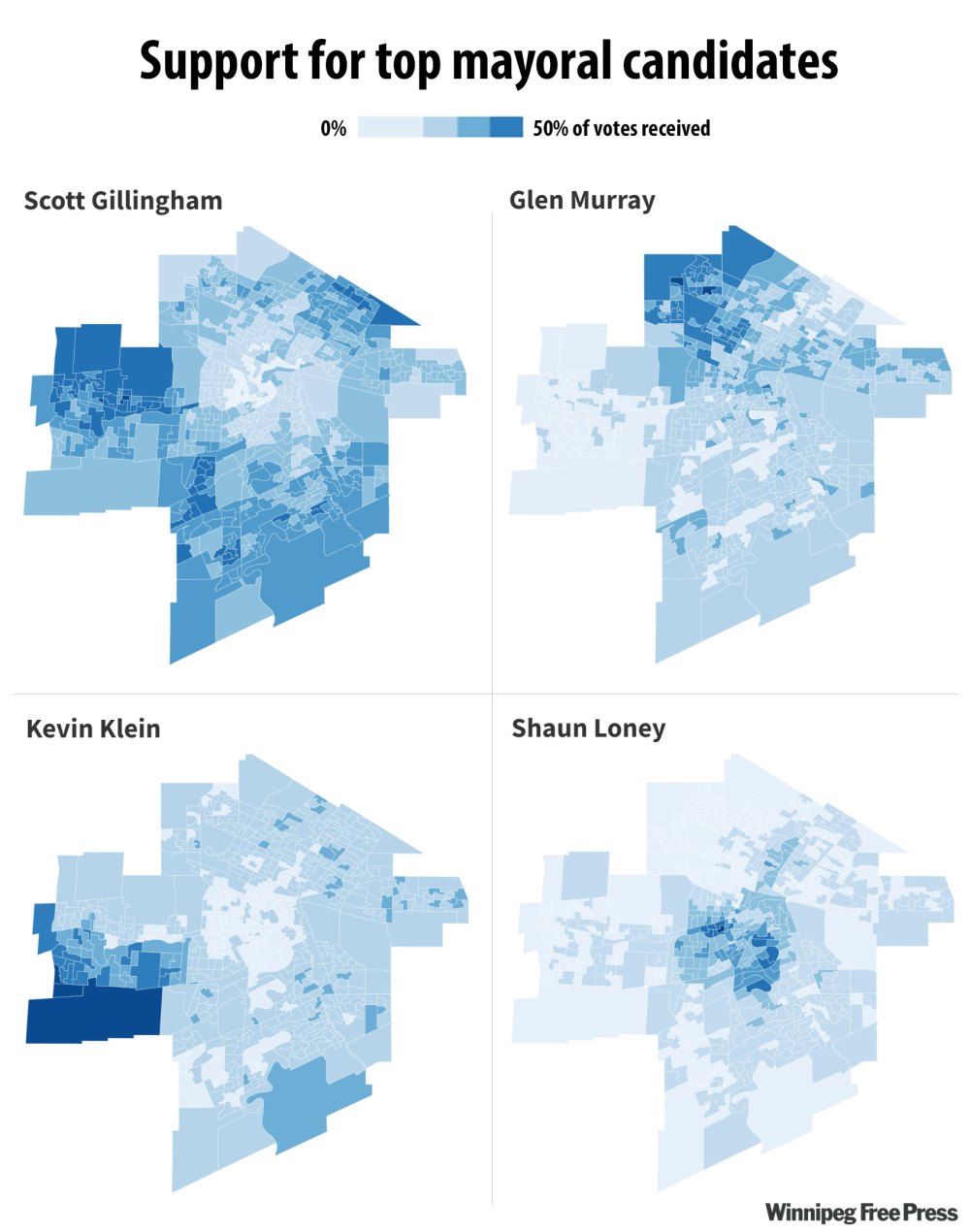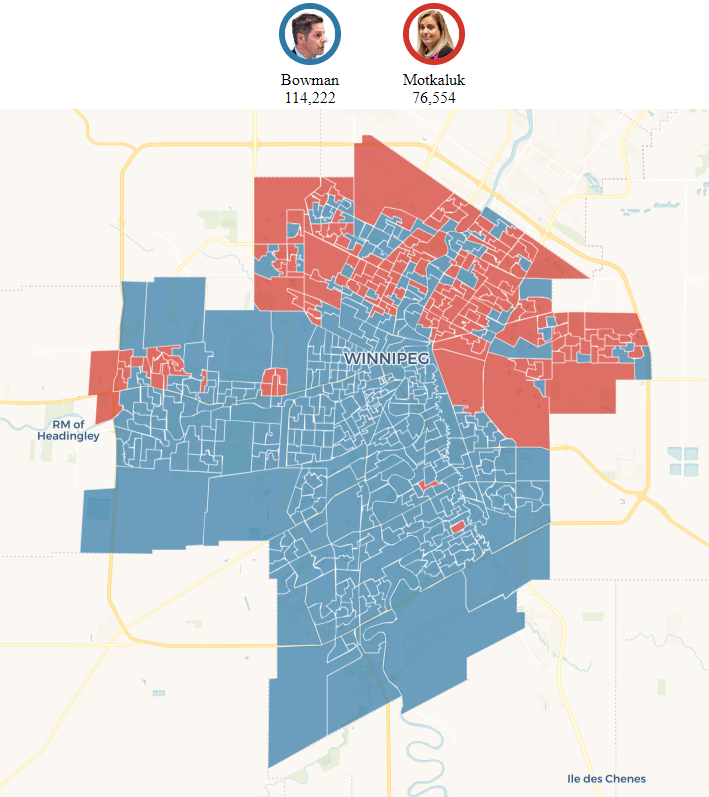Mayoral vote reveals ‘doughnut phenomenon’
Advertisement
Read this article for free:
or
Already have an account? Log in here »
To continue reading, please subscribe:
Monthly Digital Subscription
$19 $0 for the first 4 weeks*
- Enjoy unlimited reading on winnipegfreepress.com
- Read the E-Edition, our digital replica newspaper
- Access News Break, our award-winning app
- Play interactive puzzles
*No charge for four weeks then billed as $19 plus GST every four weeks. Offer only available to new and qualified returning subscribers. Cancel any time.
Read unlimited articles for free today:
or
Already have an account? Log in here »
Hey there, time traveller!
This article was published 30/10/2022 (786 days ago), so information in it may no longer be current.
Maps of Winnipeg’s mayoral election results reveal where the vote was won and lost, with Shaun Loney outperforming Glen Murray in core areas, and vote-rich suburbs propelling winner Scott Gillingham.
Graphics created by the Free Press show a doughnut-like phenomenon — rather than a north-south split — which mirrors how Winnipeg votes in federal and provincial elections, said Christopher Adams, adjunct professor of political studies at the University of Manitoba.
Much of the city’s outer ring tilted toward candidates with a conservative background in Wednesday’s municipal election, while middle wards tended to favour frontrunners seen as left of centre.

“Voters who are concerned about taxes, property crime, infrastructure and roads, we see them more supportive of the centre-right candidates than the inside part of the city,” said Adams. “With Gillingham, we see a little bit of that doughnut phenomenon.”
The maps are based on official results by polling subdivision.
Two-term St. James councillor Gillingham, who will be sworn in as mayor Tuesday, won 27.54 per cent of the vote in a field of 11 candidates.
Considered a safe choice, the former finance chair campaigned on fiscal responsibility and promises to pump more money into infrastructure by increasing property taxes and the frontage levy.
Murray, who served as mayor between 1998 and 2004, was second with 25.29 per cent. Former councillor Kevin Klein (14.78 per cent) was third and Loney (14.66 per cent) was fourth.
City-wide voter turnout was just 37 per cent.
Loney strong in inner city
Loney had a strong showing in left-leaning core areas, where turnout was lower than the suburbs, which favoured Gillingham and Klein, who is running for the Progressive Conservative nomination in the Kirkfield Park byelection.
“It’s not quite that simple, but there’s some merit to the idea that Loney may have really eaten into Murray’s support and cost him the mayor’s chair,” said Mary Agnes Welch, a principal with Probe Research.
Political observers agree Murray lost votes to other candidates due to allegations of sexual harassment and poor management when he was executive director of the Pembina Institute in 2017 and 2018. Murray denied the allegations.
NDP member Loney, seen as an alternative to Murray, wasn’t a typical left-wing candidate, given his promises to raise taxes and work with the private sector on issues such as homelessness, said Aaron Moore, chair and associate professor of the University of Winnipeg’s political science department.
He said Loney had strong support downtown because he was offering new ways to help people without housing.
Murray’s bold vision ran up against voter skepticism, said Paul Thomas, professor emeritus of political studies at the U of M.
Loney takes votes from Murray, Klein from Gillingham
New Democrats were divided over whether to work for and vote for Murray or Loney, he added.
“Given the narrow margin of victory, a few hundred votes, gained or lost, in any part of the city could have contributed to the outcome,” Thomas wrote in an email. “Loney took crucial votes away from Murray in the inner-city.
“It was also the case that (Robert-Falcon Ouellette, with just seven per cent of the vote mainly in the inner-city which he represented as an MP, also hurt Murray’s chances.”
On the flip side, Gillingham’s margin of victory over Murray likely would have been larger if he didn’t have a conservative challenger, said Adams.
“I’m sure Klein drew suburban voters away from Gillingham, and I’m convinced Loney drew the Wolseley, downtown voters from Murray,” he said. “If there had been three runners of Murray, Gillingham and Klein, without Loney, I’m quite convinced (Murray) would have won that election.
“People run on their own names. You can’t look around and say, ‘Who will I be damaging if I run?’ That’s sort of a mug’s game, so I’m not blaming Loney, I’m not blaming Klein. I’m just saying the reality, when you look at the numbers, that’s what’s happened.”
North-south split similar to 2018
Maps showed a north-south split in the 2018 municipal election, with incumbent Brian Bowman winning a second term amid strong support in the southern half of Winnipeg and inner neighbourhoods.
He decided not to seek a third term, leaving this year’s election wide open.
Candidate Jenny Motkaluk finished second that year and a distant sixth in 2022.
Moore noted Murray won a lot of the same areas of north Winnipeg and Transcona that Motkaluk won four years ago.
“Something else is happening than just a left-right divide, and I think a big part of it is if we think back to 2018, Jenny Motkaluk was promising tax freezes and Brian Bowman was talking about tax increases,” said Moore.
“We see the same dynamic when we look at Glen Murray and Scott Gillingham. It seems like the freeze tax mantra resonates more in the north and Transcona, whereas there’s a great willingness in the south and the west to embrace tax increases.”
Moore said the candidates’ tax pledges helped voters decide between the crowded field.
Two days after telling a televised debate he wouldn’t increase taxes, Murray proposed hiking the business tax.
Welch noted each frontrunner received “a little bit” of support from many areas of the city, regardless of voting traditions.
“This is not quite as simple as that suburbs vs. inner-city kind of tension we always have in Winnipeg. This is a little more nuanced,” she said. “I think these maps kind of show that.”
She is among the observers who were intrigued by the solid support for Murray in northwest Winnipeg.
“You would think lots of new Canadians or perhaps folks that are really middle class would be centre or centre-left, but more and more we’re seeing that quadrant be a little more conservative,” said Welch. “For Glen Murray, even though he was the urbanist guy, he actually ran a little bit more of a conservative campaign.”
chris.kitching@freepress.mb.ca
Twitter: @chriskitching
Chris Kitching
Reporter
As a general assignment reporter, Chris covers a little bit of everything for the Free Press.
Our newsroom depends on a growing audience of readers to power our journalism. If you are not a paid reader, please consider becoming a subscriber.
Our newsroom depends on its audience of readers to power our journalism. Thank you for your support.
History
Updated on Monday, October 31, 2022 11:14 AM CDT: Updates graphics, adds images, headers








